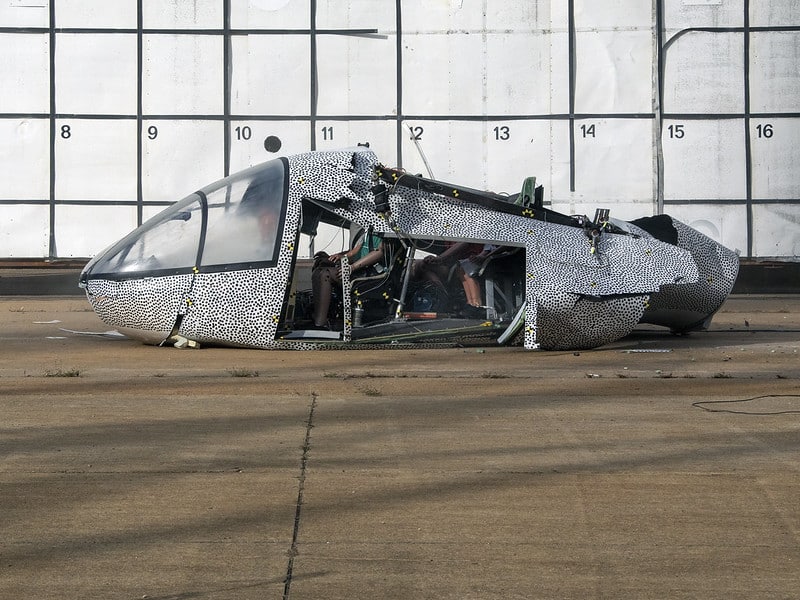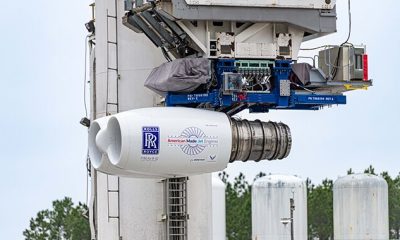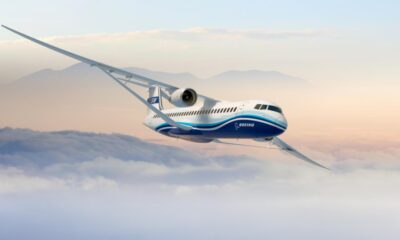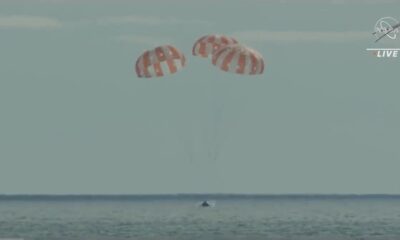Aerospace
NASA Crash Tests eVTOL Concept
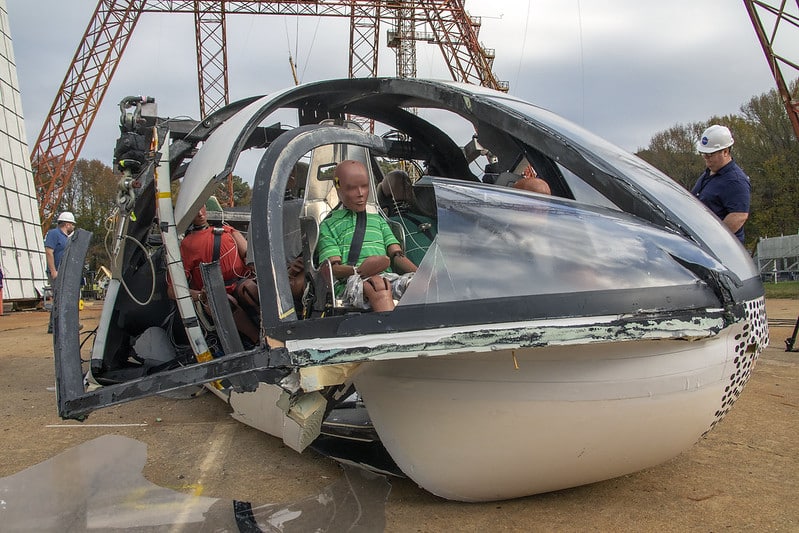
NASA researchers recently completed a full-scale crash test of an electric vertical takeoff and landing (eVTOL) concept vehicle at the Landing and Impact Research (LandIR) facility at NASA’s Langley Research Center in Hampton, Virginia.
The eVTOL was a ‘Lift+Cruise’ test article developed by the Revolutionary Vertical Left Technology (RVLT) project in another effort for NASA to advance research for the Advanced Air Mobility (AAM) mission.
NASA Orders Three More Orion Spacecraft From Lockheed Martin(Opens in a new browser tab)
NASA’s vision for AAM is to help emerging aviation markets safely develop an air transportation system that moves people and cargo between places previously not served or underserved by aviation. Understanding how these future aircraft may act in a crash scenario is another key point of research. Hoisted into the air, then released with pyrotechnic cutters, the model swung forward and down back to the Earth with a loud crash.
A variety of experiments were included on the test article. These experiments included several seat configurations including a NASA energy absorbing concept, various sizes of crash test dummies to study the effects of the crash loads on all sizes of occupants, and a modular NASA-developed energy-absorbing composite subfloor.
9 years child applies for a job at NASA here is how NASA replied(Opens in a new browser tab)
The first event was the floor crushing and seat stroking. The subfloor and energy absorbing seats functioned as intended and limited the effect of the impact on the crash test dummies. The second was the collapse of the overhead structure. The effect of the overhead structure collapse on the crash test dummies is still being determined.
For this test, an overhead-mass was designed to represent the wing structure, rotor and battery. The decision was made to assume that all the weight of the overhead structure was over the cabin. There are many other overhead-mass configurations which may behave differently in a crash.
More #eVTOL crash test footage! This was from recent testing at @NASA_Langley. Details: https://t.co/LydMHhxaYr
?️: Gary Banziger pic.twitter.com/Jdy7iMUf17
— Elan Head @[email protected] (@elanhead) December 20, 2022
The test data will be used to refine modeling techniques and reported to the AAM community so that it can be discussed. The full-scale testing data will be used to improve the simulation models such that in the future, the predictions will be more realistic. The data will further be used as the basis for evaluating potential test conditions and configurations that will be used during a drop test of a second Lift+Cruise test article, tentatively scheduled for testing in late 2023.

Aerospace
India is set to build a central command for the Air Traffic Control system, called ISHAN

India’s air traffic growth has led to increased responsibilities for air traffic control. The Airports Authority of India (AAI) is considering centralizing air traffic control for aircraft, dividing the country into four regions. The goal is to consolidate India’s segmented airspace into a single entity to improve air traffic management (ATM) efficiency, safety, and smoothness.
Recently, the AAI invited expressions of interest to develop a detailed project report for the Indian Single Sky Harmonized Air Traffic Management (ISHAN) initiative in Nagpur. Under this plan, air traffic controllers in Nagpur would handle domestic flights flying above 25,000 feet, eliminating the need for coordination among controllers in different regions.
For domestic regional flights operating above 25,000 feet, control would shift to the central command in Nagpur. This consolidation aims to enhance airline operations, increase flight handling capacity, and reduce congestion and flight times for passengers.
Currently, the AAI provides ATM services over Indian airspace and adjoining oceanic areas, covering over 2.8 million square nautical miles. This airspace is divided into four flight information regions (FIRs) in Delhi, Mumbai, Kolkata, and Chennai, along with a sub-FIR in Guwahati.
FIRs are responsible for providing air traffic services, including weather information, visibility, and search and rescue assistance. The proposed unification under the ISHAN initiative aligns with the projected growth of the aviation industry, which anticipates a doubling of domestic passenger traffic by 2030.
Aerospace
Does AirAsia show interest in Comac aircraft in the future?
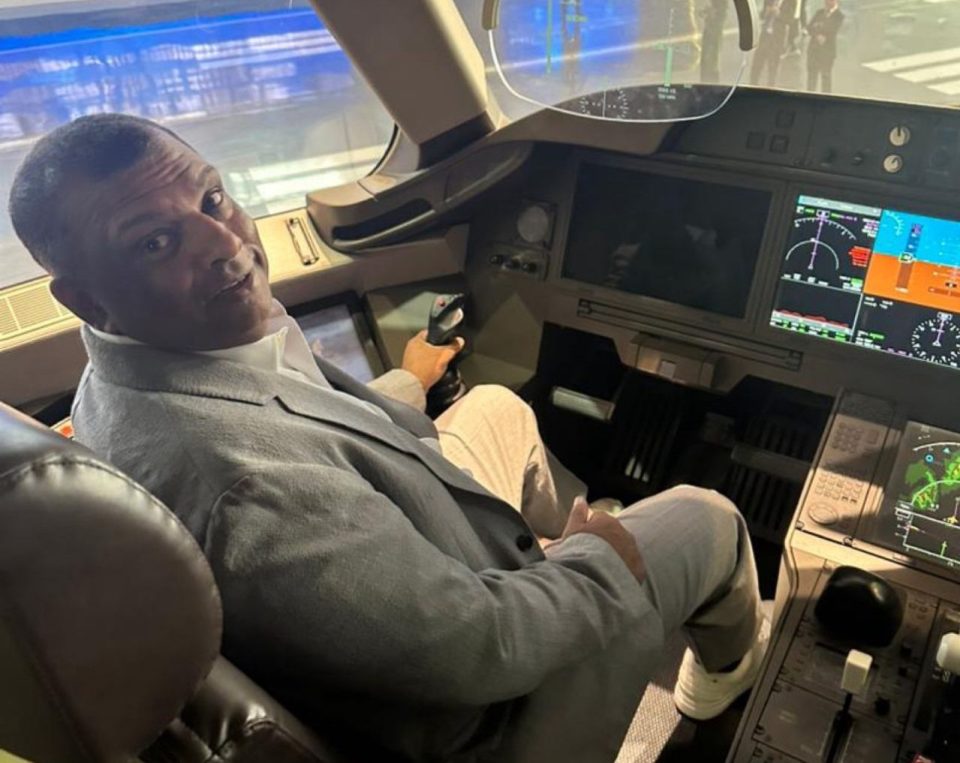
Tony Fernandes, CEO of Capital A, operating as AirAsia Group, recently paid a visit to the facilities of COMAC on April 2, 2024, and was thoroughly impressed by what he witnessed.
C919 already securing nearly 1000 orders
COMAC, known for its homegrown aircraft, has launched two promising jets: the ARJ21 and the C919 aircraft. Both aircraft are gaining popularity in the Chinese market, with the C919 already securing nearly 1000 orders from various airlines.
Fernandes expressed his admiration for COMAC’s achievements in aircraft manufacturing, acknowledging the immense challenge it entails. His visit underscored the realization that AirAsia now has a viable third option when it comes to selecting aircraft for its fleet.
During his tour, Fernandes was delighted by the innovation and technology evident in COMAC’s aircraft production and the company’s commitment to long-term partnerships.
He noted that many Western companies have shifted away from prioritizing loyalty and customer service, opting instead for short-term gains and a narrow definition of success.
Last month, COMAC embarked on an international tour, showcasing demonstration flights to neighboring countries, particularly Indonesia and Malaysia. Fernandes believes that the positive impression left by COMAC during his visit opens up new opportunities for collaboration.
Fernandes emphasized COMAC’s remarkable achievements
The shared values of loyalty, customer service, and long-term vision align closely with AirAsia’s ethos, making collaboration with COMAC appealing. With a focus on innovation and excellence, both companies stand to benefit from a partnership grounded in trust and a shared commitment to success.
Indonesia and China have already collaborated in validating and maintaining the airworthiness of the ARJ21 aircraft, indicating a solid foundation for future partnerships.
In his statement, Fernandes emphasized COMAC’s remarkable achievements and genuine desire for long-term partnership, highlighting the absence of ego and a genuine willingness to succeed together. He marveled at COMAC’s fully automated, AI-driven factory, a testament to their dedication to innovation and efficiency.
Fernandes criticized Western firms for prioritizing short-term gains over loyalty, customer service, and long-term strategy, emphasizing the importance of understanding customers’ needs and collaborating to achieve success.
Aerospace
Indigo will soon launch Air Taxi Service in India

InterGlobe Enterprises, the parent brand of IndiGo, is set to revolutionize travel in India with its upcoming air taxi service.
Scheduled for a potential launch in 2026, this innovative venture promises a seamless journey for passengers between two bustling hubs. Delhi and Gurgaon in Haryana. The forthcoming service is projected to revolutionize the daily commute, offering passengers a swift aerial journey covering the distance in a mere 7 minutes.
This remarkable efficiency contrasts starkly with the conventional 90-minute drive, underscoring the immense time-saving potential for commuters. The anticipated fare, ranging from Rs 2,000-3,000, makes this innovative mode of transport not only swift but also remarkably competitive in pricing.
At the heart of this ambitious endeavor lies a strategic partnership with Archer Aviation, a pioneer in electric vertical takeoff and landing (eVTOL) aircraft technology. Under this collaboration, Archer will supply 200 state-of-the-art eVTOL aircraft, representing an investment of US$ 1 billion. These cutting-edge aircraft, capable of accommodating up to four passengers alongside the pilot, epitomize the future of sustainable air travel.
Powered by six battery packs, Archer’s eVTOL aircraft boast rapid charging capabilities, enabling a swift turnaround between flights. With a charging time of just 30-40 minutes, these eco-friendly aircraft ensure minimal downtime, maximizing operational efficiency.
Similar services are anticipated to be introduced by the joint venture in Bengaluru and Mumbai as well. Nevertheless, the service rollout period has not yet been made public by the company. Next year, it is anticipated to get its certification. Following this, the company will start the certification procedure with the Directorate General of Civil Aviation (DGCA).

